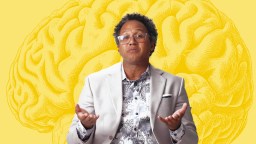JUDITH BRUCE: Financial literacy is kind of bedrock to any long-term change pretty much for everybody, but certainly for females. The world spends a lot of time talking about the SDGs—these are the Sustainable Development Goals, they mention all sorts of goals—health, equality, participation—that cannot be realized unless you have some authority over resources. You can know a right, but if you don't have a way of getting that right or a bargaining position then it's just an idea. For girls, they begin to see themselves as just an extended part of other people, they begin to define themselves as doing household and "domestic activities". They don't see themselves for what they are, which is vital economic actors. So the first thing financial literacy does is it says you're an economic actor, you're making economic choices every single day with the way you use your time, the way you use scarce resources; much of the work that you do makes it possible for someone else to do some other work. So just an identification.
Financial literacy also means building specific capabilities, being able to analyze situations, risk situations, and opportunity situations. For example, when you're working with a population which has never thought of themselves as being economic contributors, if you ask the question, "Well, imagine that you're a girl of 12 in domestic service, what are the times that you are in the riskiest position?" And then people will say, "Well, oh, when you asked for your salary, because if they don't give it to you you have no recourse you're on the street." If you ask, for a young married girl, "How is it she's going to choose a number and timing for children?" Well, she's not. She's not unless she has some bargaining position with her partner. If the partner has complete control over her, sexually, and her fertility, she has no way of saying, "I don't want to have a child now," or, "I want to wait," so her being able to control some resources and not feel completely dependent.
What happens often is that young women, females, are working and they're earning but they are not able – they're trying to save but they're turning over almost all of what they make and their time to other people. So financial literacy makes them aware of the fact that they are, daily, supporting not only themselves but others.
It also teaches real world financial inclusion skills. What are different kinds of savings? What different kinds of savings do you need to have? You need to have emergency savings, because particularly for the poorest, if you don't have some money aside for an emergency then a young female in particular is at immediate high sexual risk, or she may need emergency savings to help another family member. Then there are longer-term savings, which are goal oriented, for example, saving up towards education. We have in our work something called the cash flow tool, and I remember in Haiti after the earthquake we became aware that there was a catastrophic level of sexual violence against the girls, and most of these households were run by beleaguered women, lean-tos—it was a desperate situation. The programs that did exist were called "child-friendly spaces," which lump boys and girls together, and ultimately in most cases had older boys only and were unsafe places for girls. The bathrooms were put in places that the girls couldn't get to safely, and there was a kind of – they were like war zones. So in July, after the earthquake, we had a workshop in Haiti and we started talking about at what age did a girl in Haiti need to really understand not only her safety, but how to resource for herself safely? And we had previously put the age at eight, and we had a 12-year-old there, and she said, "No, no, it's six. It's at six girls need to know this information."
In that setting, we often brought out something called the cash flow tool. So we asked people to draw pictures of several different types of girls by age and by education, and then we asked them now list the places from which such girls get money. And girls do get money from little chores, they get money they're sometimes given, and they're very good savers, so that's on one side. And then on the other side there's a listing of, "And what does this girl need to spend on?" And they make that list as well. And then we say, "Alright, so what's the most important source for the money?" And then they circle that. "And what's the most important item on their budget that takes the most money?" And they circle that. And then people begin to see that there is an imbalance, sometimes they're actually taking more money in than they need to spend, so we always say, "Well what you can save is the difference between what you want and what you need."
So it's a process of becoming very conscious, not only of your contributions but how you can manage often in scarcity.
I think it's valuable for anybody. When my children were growing up I couldn't find a financial literacy course. There is a great book that Susan Orman wrote called 'Young, Broke and Fabulous' and I thought it was terrific because it would take real scenarios that you actually faced; you have very little money but you really need a car. What are your real choices? And that's another thing that financial literacy does, it lays out reality-based scenarios. It doesn't talk to you as if you're middle-aged and are making a big salary and buying your first house, it outlines real scenarios of economic risk and need. And then it says, "How would you negotiate it?"
If you're a young poor female what you have to do is very different than if you're an older male. Most of the prescriptions for the older and better-off populations will have no place with these girls. Then you have a real conversation with the girls. So what will it really take for you to get school supplies this year? What will it really take for the rent to be paid without someone – story from Kenya – introducing very simple budgeting. One of the girls we were working with came back and said to her mentor, "This was the first year basically I didn't have to go out and sleep with my boyfriend without a condom, because we had enough money to cover the rent in November, which was just before school fees were due." That's how close the margins are, but you have to get down to that level of reality.
And one more thing I want to say, when you have a sense of control for one part of your life, it extrapolates to another. So for example in South Africa one of my colleagues did wonderful research, Kelly Holman and her associates, and they introduced in a school setting in South Africa, which was also in the highest HIV zone where, again, much higher rates of HIV infection among females than males, and thought the financial literacy would be core, not just because people need livelihoods but because it would make information, for instance, about HIV much more salient.
At the beginning of the program the girls, it was girls and boys, they were separated for some sessions and together for others, were asked, "Do you think of yourself as being at any exceptional risk for HIV?" And these were girls often 15 with a partner who was 25 years old in a zone with 25 percent HIV prevalence. And they would say, "No." Have you been HIV tested? "No." After several months of financial literacy, their incomes hadn't changed, their savings hadn't changed, but their idea that there was some aspect of their life economically that they could changes, so they were asked, "Do you have a financial goal?" And that didn't mean you had achieved it, but you had a goal. The girls, just having a financial goal, changed their ability to realistically assess their HIV risk. If they had a partner ten years older they thought, "Maybe I should get a different partner." They were much more likely to get tested. They saw a scope, that information of just psychological control and recognition immediately translated into being able to mobilize health information. So where good health is always valued, health doesn't drive economics as strongly as economics drive health. Without economic resources it's difficult for females especially to make good health decisions.





